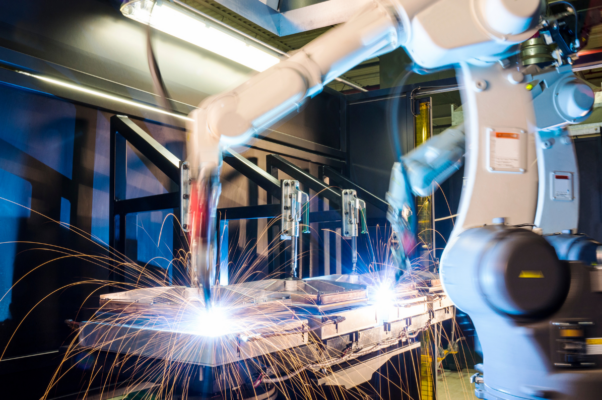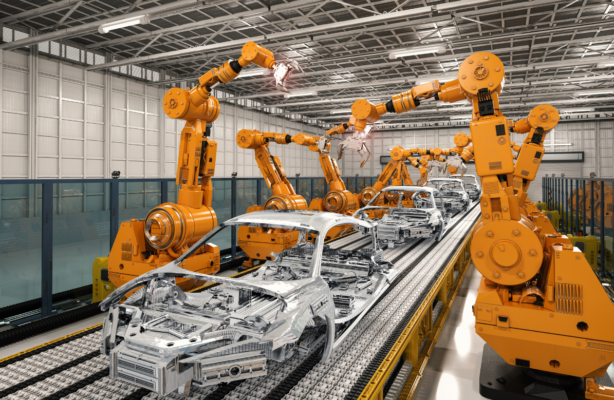Thinking about automating your manufacturing line? Knowing how much industrial robots cost is key. These robots speed up production, improve safety, and boost efficiency. But, prices vary a lot. They depend on the robot’s type, what it can do, and the tasks you need it for. Before you start budgeting, it’s vital to understand what you’re paying for.
This guide will help you figure out the costs of adding industrial robots to your workflow. You’ll learn what to expect financially, making sure you’re ready to make a smart investment.
What is an Industrial Robot?
An industrial articulated robot is a robot with rotary joints, giving it a wide range of movement. These robots usually have six degrees of freedom, allowing them to perform complex tasks with precision. You’ll find them in manufacturing and production environments, handling tasks like welding, material handling, assembly, and machine tending.
Understanding Industrial Robot Costs:
Diving into the world of industrial articulated robots? Here’s what you need to know about their costs, broken down into simpler terms.
Size Matters:
The bigger and stronger the robot, the more you’ll pay. It’s like the difference between a bike and a pickup truck; both get you places, but one can carry much more.
Accuracy Counts:
If your tasks need super precise movements, be ready to spend extra. It’s like choosing a high-end gaming PC over a basic laptop for those crisp graphics.
Choose Wisely:
Picking a robot from a well-known brand might cost a bit more now, but it’s usually worth it for the quality and support you get. Think of it as buying a trusted brand TV versus a no-name one.
Software Smart:
The robot’s software needs to work with your current systems. More advanced software means a higher cost, similar to buying premium software for your computer.
Custom Fits:
Customizing the robot’s tools for specific jobs can add up, just like adding all the top features to your new car.
Setup and Support:
Getting your robot up and running and teaching your team how to use it also costs money. It’s like paying for installation and training on new office software.
Understanding these key points helps you see why articulated robots cost what they do. You’re not just buying a robot; you’re investing in a tool designed to fit your specific manufacturing needs perfectly.
Types of Industrial (Articulated) Robots and Their Cost Ranges:
Articulated robots are the all-stars of the industrial world, bending and twisting in ways that can tackle almost any task on the manufacturing floor. But not all articulated robots are created equal. Their costs can swing wildly, depending on their size, capabilities, and the tech packed inside. Let’s break down the types and what you might expect to spend.
Small Articulated Robots:
These compact powerhouses are perfect for tasks in tight spaces, like assembling small electronics. Think of them as the nimble gymnasts of the robot world. Price-wise, they’re on the lower end of the spectrum, starting from around $25,000. They’re your entry-level option, offering flexibility without a hefty price tag.
Mid-sized Articulated Robots:
Stepping up in size, these robots handle a broader range of tasks, from packing boxes to simple welding. They’re the utility players, not too big, not too small, and priced between $50,000 to $100,000. For many manufacturers, they strike the perfect balance between capability and cost.
Large Articulated Robots:
These are the heavy lifters, capable of moving large parts or performing tasks that require significant reach and strength. With their size comes a bigger price tag, often ranging from $100,000 to $150,000 or more. They’re the industrial equivalent of heavy-duty machinery, designed for the toughest jobs.
Remember, these prices are just the starting point. Adding advanced sensors, custom end-of-arm tooling, and sophisticated software can drive up the cost. Plus, you’ll need to factor in installation and ongoing maintenance. Choosing the right type of articulated robot is about matching your specific needs with the robot’s capabilities, ensuring you invest wisely for your manufacturing goals.
Key Cost Factors for Your Industrial Articulated Robot: What to Know
Investing in an industrial articulated robot? Here’s a closer look at what shapes its price, helping you make a smart choice.

Functionality & Custom Needs:
Think about what you need your robot to do. Robots that can perform precise tasks or are tailored for specific jobs cost more. It’s like paying extra for a custom-built computer that meets your exact gaming or work needs.
Lifespan & Toughness:
How long your robot lasts and how well it handles tough conditions matter. Robots built for extreme environments, like high heat or chemicals, are pricier. They’re the rugged off-road vehicles of the robot world, built to last.
Energy Use:
The more energy-efficient your robot is, the more you might pay upfront. But, just like LED bulbs save on your electric bill, these robots cut costs in the long run.
Fitting In:
How easily your robot fits into your current setup can affect its price. If it needs extra gear to work with what you have, that’s more money. It’s similar to updating your old computer to run new software.
Training & Support:
Good training and support from the manufacturer mean your robot gets up and running smoothly but expect to pay for this premium service. It’s like buying a warranty for a new gadget, ensuring help when you need it.
Safety First:
Robots with advanced safety features, like automatic stop if someone gets too close, are crucial for working alongside people. These safety add-ons are like the latest car safety tech, protecting everyone involved but adding to the cost.
Understanding these detailed factors helps you see the full picture of what you’re paying for. This knowledge ensures your investment in an articulated robot matches your needs and budget, setting you up for long-term success.
Hidden Costs to Consider:
Thinking about adding an industrial articulated robot to your team? There’s more to consider than just the purchase price. Let’s dive into the extra costs you might not see coming.

Setting Up:
Installing your robot isn’t always straightforward. You might need to make space or upgrade your facilities. It’s like needing extra cables and a new TV stand for that big-screen TV you just bought.
Adjusting Your Workflow:
When your robot starts working, things might slow down at first. Your team and the robot need time to learn how to work together well. It’s like breaking in a new pair of running shoes; it takes a bit of time to get comfortable.
Upkeep and Fixes:
Your robot will need regular check-ups to stay in top shape, and repairs can be expensive. Think of it like having a car; maintenance and unexpected repairs are part of the ownership.
Learning to Use It:
You and your team will need to learn how to use the robot safely and efficiently. This might mean paying for training. It’s similar to taking a course to learn a new software for work.
Knowing these hidden costs up front helps you plan your budget better. It makes sure you’re fully prepared for the total investment of bringing an industrial articulated robot into your production line.
How to Budget for an Industrial Robot:
Planning to buy an industrial articulated robot? Here’s a simple guide to budget for it wisely.
Check the Price Tag:
Start with the robot’s price. This is just the beginning.
Add the Extras:
Include costs for setting it up, making space in your workspace, and any special tools it needs. It’s like when you buy a phone and then need a case and charger.
Remember Maintenance:
Robots need check-ups and fixes. Set aside money each year for this, similar to how you budget for car maintenance.
Train Your Team:
Your staff needs to learn how to work with the robot. Factor in training costs, viewing it as an investment in your team.
Have a Safety Net:
Always keep extra money in your budget for surprises. Things don’t always go as planned.
Look at Payment Plans:
Explore loans, leasing options, or grants to help spread out the costs, just like you might finance a big purchase.
Work Out the Payback:
Weigh the costs against the benefits. How much will the robot save you in time and money? This tells you when you’ll start seeing returns.
Following these steps helps you cover all bases, ensuring you’re ready for both the upfront costs and the long-term investment of getting an industrial articulated robot.
Conclusion:
So, you’re thinking about adding an industrial articulated robot to your lineup. It’s a big step that can really change how things run on your floor. To make it work, you’ve got to think about everything: the upfront cost, the setup, keeping it running, and teaching your team to use it. Get all these costs in your budget to avoid surprises. With the right planning, you can boost your efficiency and productivity big time. Ready to take on the future of making things? Do it with confidence, knowing you’ve looked at all the angles and made a smart move for your business.
Do you want to compare different Industrial Robots?






